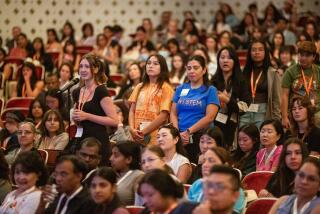Schools Badly Shortchange Girls--Report
- Share via
From the way courses are designed to the methods teachers use to bestow attention on students, America’s public schools are badly shortchanging girls, furthering inequities that hinder the choices they make as adults, the American Assn. of University Women contends in a landmark report to be released today.
The report pulls together two decades of research to provide the most comprehensive look to date at the bias girls face from preschool through high school. Among its findings:
* Teachers give girls significantly less attention than boys.
* Although the gender gap in math is declining, girls still are not pursuing math-related careers in the same proportion as boys are, and a large, and perhaps growing, gender gap persists in science.
* Curricula often ignore females or reinforce stereotypes.
* Most standardized tests are biased against girls.
In addition, the study found indications that African-American girls fare even worse than white girls in classroom interaction. Although black girls try to initiate more teacher contact than any other group, they are frequently rebuffed and usually receive less teacher reinforcement.
Further, the report found that sexual harassment of girls by boys is on the rise, in part, the authors say, because school authorities tend to dismiss the incidents as “harmless instances of ‘boys being boys.’ ”
The study concludes with 40 recommendations aimed at increasing all students’ chances of receiving equitable treatment.
Noting that the majority of workers entering the job market by the turn of the century will be women or minorities, AAUW officials said the inequities evidenced in the study must be reversed if the United States is to be competitive in global markets.
“Construction of the glass ceiling begins not in the executive suite but in the classroom,” Alice McKee, president of the AAUW Educational Foundation, said of women’s difficulties in rising to key leadership positions in business, the professions and academia.
“It starts in preschool, when girls get less teacher attention, and lessons focus on the developmental needs of boys,” McKee added. “By the time girls reach high school, they have been systematically tracked toward traditional, sex-segregated jobs and away from areas of study that lead to high-paying jobs in science, technology and engineering. America cannot afford to squander half its talent.”
The report was scheduled for discussion today by prominent educators at the AAUW’s National Education Summit on Girls, being held in Washington. It also will be the subject of an AAUW-sponsored seminar for California education, business and government leaders Feb. 28 in San Francisco.
It follows an AAUW-commissioned poll last year which found that girls, unlike boys, do not generally emerge from school with the same degree of confidence and self-esteem with which most began their education.
AAUW President Sharon Schuster said the organization commissioned the study because of concerns that “girls are invisible” in the years-long national debate over how to improve American schools. A review of 35 major reports over two decades found only four that made any substantive references to girls’ problems in the educational system, she said.
Among the group’s recommendations were strengthening enforcement of a 1972 law banning sex discrimination in federally funded education programs; better training of teachers, counselors and administrators to avoid gender bias; revamping courses to expand opportunities for girls, and the elimination of gender stereotyping in matters ranging from discipline to textbooks.
As for standardized tests, researchers found that when scholarships are given based on the Scholastic Aptitude Test, the most widely used college entrance exam, boys are more apt to receive them than girls who get equal or slightly better high school grades. Further, of boys and girls with the same math SAT scores, the girls do better in college.
Many of Orange County’s 21 chapters of the AAUW have programs under way to erase gender bias in schools. The Huntington Beach chapter, for example, has an active mentor project pairing girls in the sixth, seventh and eighth grades with women in various careers.
“We especially try to identify girls who might be successful in school now but who need encouragement to continue on to college,” Huntington Beach chapter president Pat Cohen said. “We have found that time and again that it’s the middle-school girl who is at risk. While they do equal or better than boys at the fourth-grade level, by the time they are in high school, they are behind.”
One of the reasons boys get more attention in the classroom--a consistent finding in research spanning 20 years--is that they demand more. For example, researchers Myra and David Sadker of American University in Washington found that boys called out answers to teachers’ questions eight times more frequently than girls did. Further, the Sadkers found, teachers responded differently to such behavior, rewarding boys who called out by giving them attention but chastising the girls by reminding them to raise their hands before speaking.
Education professors who train student teachers to avoid gender bias can fall into stereotyping patterns, too, despite their best efforts.
“One woman on our faculty went into a classroom recently and she realized that she was only calling on the boys,” said Judith Ramirez, chair of Cal State Fullerton’s child development department. “It’s because the boys are there waving their hands and girls aren’t. Unless you are absolutely conscious of trying to make access equal, (gender bias) happens.”
Many teachers will argue that it doesn’t occur in their classroom, said Jeanette Miller, a former teacher of 17 years and member of AAUW’s Newport Beach-Costa Mesa chapter. “But researchers who go into classrooms find that it does. And when it is pointed out, the teachers are very surprised,” Miller said. “They’re not doing it on purpose.”
Researchers at Cal State Fullerton also have discovered that from the very earliest ages, boys tend to monopolize toys and learning tools in a classroom.
‘We have found for example if you don’t have enough computers, the boys will use them all,” said Ramirez. “If there are plenty, girls will use them too. But if there’s a scarcity the girls give way and the boys use them all the time. . . . At younger grades, the girls have a hard time getting to use colored blocks. So there’s a whole set of spatial skills girls don’t get to develop equally.”
Schuster said she found a bright spot in the “full support of the education Establishment. . . . Once their consciousness is raised, they want very much to make a change.”
One of those already making a change is Betsy Adams, a math teacher at William Logan Stephens Middle School in Long Beach.
Adams, a 20-year veteran, said she became aware of gender issues during a 1990 summer workshop at Mt. Holyoke College in Massachusetts and began experimenting with ways to encourage girls to develop their talents in mathematics.
She switched to a cooperative learning approach, in which students work together in small groups to solve problems, and she began taking more time before selecting a student to call on. She also began having students keep track of the number of times she called on girls and how many times she chose boys--with some interesting results.
“When I called on girls and boys an equal number of times, all the students perceived I was favoring girls--they were that used to girls being in the background,” Adams said.
But she makes it clear that she is not interested in only helping girls.
“I’m not neglecting my male students by any means,” Adams said. “What works for girls also works for boys, and no one gets left out.”
Throughout Orange County, girls are being targeted by a host of programs aimed at boosting science and math skills. Cal State Fullerton has just completed a two-year summer project with high school juniors who excelled in every area but math and science. After intensive math training at the college, 22 of the 32 girls originally in the program went on to college last fall, program coordinator Ina C. Katz said.
“Our students are doing wonderfully well, and their math achievement is spectacular,” Katz said.
Test scores of the first group of 32 students in 1990 improved their skills by an average of 52% in Algebra I at the end of a four-week summer session, she said. Among the 11 students who returned for the second summer session in 1991, test scores improved another 48% for Algebra I and 78% in Algebra II.
“These were students who without intervention would not have been eligible for college because they didn’t meet the math requirements,” Katz said. “And these were mostly underrepresented minority girls.”
Times staff writer Kristina Lindgren contributed to this article.
BACKGROUND
The American Assn. of University Women last year commissioned the Wellesley College Center for Research on Women to compile a report synthesizing hundreds of published and unpublished studies conducted over the last two decades on girls and schools by researchers in colleges and universities, government agencies and private groups. The Wellesley Center also conducted interviews with key policymakers, classroom teachers and school administrators. The result of the 12-month project was “How Schools Shortchange Girls: A Study of Major Findings on Girls and Education,” the most ambitious effort to date to assess the status of girls in public education.
More to Read
Sign up for Essential California
The most important California stories and recommendations in your inbox every morning.
You may occasionally receive promotional content from the Los Angeles Times.











